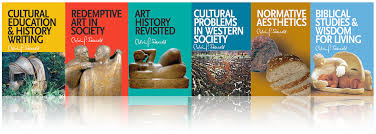
A PUBLISHING EVENT
A publishing event.
It is a phrase I’ve used a few times but, for obvious reasons it must be employed only sparingly. Most often it is reserved for the release of, say, a previously unpublished work by a classic author. (Speaking of which, a new edition of Roald Dahl’s classic YA book Charlie and the Chocolate Factory has been released with a recently discovered, long-missing chapter. Now that’s a publishing event for you!)
Sometimes the phrase may indicate the significance of a new volume, perhaps a second novel of a highly acclaimed, exceptionally gifted writer, or maybe a new Bible translation destined to become widely esteemed and used (like, say, the release of the ESV in 2001.) Occasionally it may refer to a major new scholarly contribution that promises to change paradigms, rocking the worlds of science or medicine. If the blockbuster sales promise to be large enough – think Harry Potter or The Hunger Games – some refer to the release date as a publishing event.
The phrase is sometimes used too quickly, I think, cheapening it.
That said, I can’t think of any other way to describe what I felt and how I came to think about the announcement of a 6-volume set of writings by the important Christian philosopher, aesthetician, art historian, Bible scholar, hymn writer, cultural critic, Dr. Calvin Seerveld. I know, I know, Seerveld is only known in a very small circle, a niche sub-culture, within the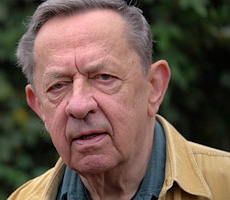 small Christian subculture, and his writing is sometimes exceptionally dense and often eccentric. Seerveld’s field, the field of the Lord in which he plays, is aesthetics, and his life-long project of developing a coherently, consistently Christian aesthetic theory, embedded in and emerging from a deeply Biblical world and life view, is seen by some to be esoteric. His artfully serious writings may seem obscure, even: digging deep into the philosophical assumptions embedded in and flowing out of a Rococo art piece, waxing eloquent with passionate insights about an off-off Broadway theater performance, detailing the good and bad, wise and deadly, of a scholar’s textbook, detailing the religiously-shaped ethics informed by particular art theories of a century ago.
small Christian subculture, and his writing is sometimes exceptionally dense and often eccentric. Seerveld’s field, the field of the Lord in which he plays, is aesthetics, and his life-long project of developing a coherently, consistently Christian aesthetic theory, embedded in and emerging from a deeply Biblical world and life view, is seen by some to be esoteric. His artfully serious writings may seem obscure, even: digging deep into the philosophical assumptions embedded in and flowing out of a Rococo art piece, waxing eloquent with passionate insights about an off-off Broadway theater performance, detailing the good and bad, wise and deadly, of a scholar’s textbook, detailing the religiously-shaped ethics informed by particular art theories of a century ago.
On one hand, Seerveld is a specialist in a specific field, and he has paid close attention to details, and it may be that this matters most to those within the scholarly arenas of art criticism, museum curating, or academic discourse.
On the other hand, who among us can’t see the implications of art’s impact on cultural trends, and how “ideas grow legs” and ripple down through the ages with consequences in our day to day days, especially when those ideas are carried into a mass market through electronic mediums like movies,TV and itunes? Dr. Seerveld’s specialized theorizing, as we shall see, even when arcane, ends up being – as they say about Holy Communion – “a gift of God for the people of God.” We should say, in response to Seerveld’s work, “thanks be to God.”
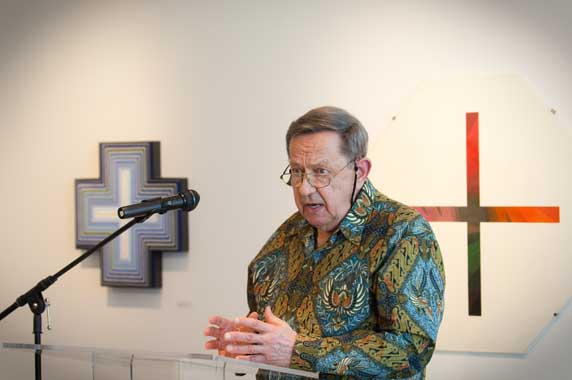 Calvin Seerveld is a hero to many of us, modeling as he has, a commitment to serious, world-class, inter-disciplinary scholarship, one whose remarkably detailed, arcane professional work usually ends up sounding very, very important. Even if one doesn’t know much about art history, say, or the discussions about public art in Canadian cities, or the perspectives and practices emerging from recent study about play and recreation, reading Seerveld makes one realize how it does matter. Like a truly good teacher, he helps us “get it.” Without jumping to simplistic or moralistic “practical applications” his perspective comes through his robust, scholarly essays, papers, talks, or sermons, and get into one’s bones in transforming, sometimes Earth-shattering ways. His insights, both the big, broad conclusions and the smaller allusions offered in detailed lines are — to use a phrase I swear I first heard from Cal, probably at a Jubilee conference in the mid 70s — “pregnant with meaning.”
Calvin Seerveld is a hero to many of us, modeling as he has, a commitment to serious, world-class, inter-disciplinary scholarship, one whose remarkably detailed, arcane professional work usually ends up sounding very, very important. Even if one doesn’t know much about art history, say, or the discussions about public art in Canadian cities, or the perspectives and practices emerging from recent study about play and recreation, reading Seerveld makes one realize how it does matter. Like a truly good teacher, he helps us “get it.” Without jumping to simplistic or moralistic “practical applications” his perspective comes through his robust, scholarly essays, papers, talks, or sermons, and get into one’s bones in transforming, sometimes Earth-shattering ways. His insights, both the big, broad conclusions and the smaller allusions offered in detailed lines are — to use a phrase I swear I first heard from Cal, probably at a Jubilee conference in the mid 70s — “pregnant with meaning.”
And so, dear readers, friends of Hearts & Minds, join me as I make the case that the release of this extraordinary collection of occasional pieces – major addresses, keynote talks, academic papers (a few published in chapters of hard-to-find books published in Africa or Amsterdam) and many popular-level articles published in magazines, not to mention a few sermons and hymns and Bible studies and lovely meditations – ought to be consider a bona fide publishing event. From the largest literary stars rocking the best-seller lists to brilliant work coming from cryptic indie-publishers, from important new scholarship in the mainstream academic guilds to the large renaissance of important Christian scholarship available from publishers like Eerdmans, Baker Academic or IVP Academic, I can say that there is simply nothing that has been published in recent years that is as ambitious, as fascinating, and – dare I say it? – as important, as this collected works project of Dr. Calvin G. Seerveld, son of a Long Island fishmonger.
BEARING FRESH OLIVE LEAVES (OR: “COMMON GRACE FOR THE COMMON GOOD”)
Steve Garber’s nice phrase from the subtitle of his Visions of Vocation, “common grace for the common good,” captures something of the tone of Seerveld’s work. (Garber esteems Cal Seerveld greatly, by the way, and Seerveld was an early influence on him, along with their mutual friend, the Dutchman Hans Rookmaaker.) Seerveld brings profound insight to the watching world. Which is to say that although he is one of the most overtly Christian scholars I know (Scriptural references pepper his talks, Biblical stories and theological allusions show up in the most fascinating ways) his work is read by scholars who do not seem otherwise interested in Christian convictions. His work has won prestigious scholarly awards and some of his presentations were first delivered in very public forums. One volume of these six (Cultural Problems in Western Society) includes, in fact, six serious presentations given in Europe at a series of annual conferences paid for by the Dutch government, bringing together policy advocates and civic activists, artists, labor union leaders, and cultural workers, who were tasked to think together deeply about the changing culture in Europe, especially given the rise in immigration and the increase in tensions arising in an increasingly secularized and multi-ethnic society.
I reviewed that one briefly for the Citizens for Public Justice newsletter, Capitol Commentary, reminding that particular audience that Seerveld is useful for those committed to nurturing principled convictions about citizenship for the common good. Seerveld is perhaps an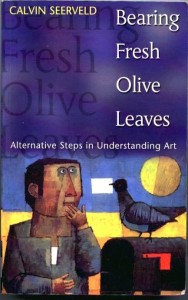 example of what we sometimes call a public intellectual. Common grace for the common good, indeed.
example of what we sometimes call a public intellectual. Common grace for the common good, indeed.
(Seerveld has a previous and quite brilliant book of essays about the arts, including some wonderful talks he gave at the famous Greenbelt Festival in England, entitled, with Noahic overtones, Bearing Fresh Olive Leaves. Yes, that’s it — we bring gifts of promise, pointing others towards God’s gift of shalom a-coming. Again, this is language of the common good; love of neighbor seems to be palpable in even his art theories, educational proposals or civic studies.)
It is fair to say, though, that Seerveld is mostly known in certain Christian circles – he is Dutch Reformed, a neo-Calvinist standing in the Kuyperian legacy who studied with Barth and other heady continental theologians, a son of a New York fish seller who has served as gritty cheerleader and very vocal supporter of the struggles of the rough and tumble Christian Labour Association of Canada, a founding professor of the embattled Institute for Christian Studies in Toronto, the first Christian institution in North America to offer PhD degrees (in subjects other than Bible or theology) in an knowingly, intentionally Christian program. His work at ICS helped them earn their world-wide reputation, even though the hugely significant Creation Regained: The Biblical Basis for a Reformational Worldview by Al Wolters, a good friend and former colleague of Seerveld’s there, is now better known. (It was Seerveld, by the way, who coined that phrase “reformational” to distinguish the neo-Calvinism of Kuyper, Dooyeweerd, Vollenhoven and the movement of scholars from Amsterdam and Toronto’s ICS from the more conventional Reformed theology known in the States.)
Cal’s friend Nicholas Woltersdorff, who left Calvin College to take up a position at Notre Dame and then Yale, and eventually the equally prestigious UVA, is a similar scholar who is also widely read; his books are on Cambridge University Press, and other renowned scholarly presses, and his Eerdmans Art in Action is considered a watershed book on Christian writing about aesthetics. I mention him for those who may know his serious work in aesthetics and political philosophy, but who oddly may not have read Seerveld; they are good friends and working in somewhat similar terrain. (And both will be on a panel at the upcoming CIVA conference in June of 2015.) Seerveld seems more evangelically passionate, his wildly colorful style allowing his seriously informed academic ruminations to feel on the page like revival fire. Perhaps this is why he did not, like Nick, end up respected in the Ivy League; Seerveld is perhaps too rambunctious and less willing to obscure his own deepest orientation. At any rate, perhaps knowing the long-standing friendship between Nick and Cal will help you place Seerveld in the larger landscape of what we sometimes call integrated Christian scholarship. 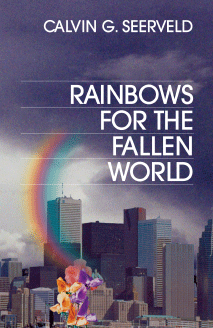
Seerveld’s Rainbows for the Fallen World (published by his own Toronto Tuppence Press) is a study done in evocative, passionate, eccentric prose, part sermon, part philosophy, part chat with older Dutch Uncle, part exhortation from what sounds like a not so minor prophet, and is perhaps his most well-known work. It is cited by many of our smartest evangelical artists and cultural creatives — Mako Fujimura, Andy Crouch, Charlie Peacock, Michael Card, the late Mark Heard, the publisher Ned Bustard of Square Halo Books, guys in Jars of Clay, William D. Romanowski, not to mention leaders at organizations like CIVA, IAM, the XD team of the CCO, and Fuller’s Brehm Center for the Arts. We are proud to sell it, and have sent it around the world.
Justice advocate and former leadership mentor at the Max DePree Center for Leadership Gideon Strauss writes of Seerveld:
I cannot adequately express my own gratitude for Calvin Seerveld’s lifetime of faithful study, writing, and speaking. I first bought a copy of Seerveld’s Rainbows for the Fallen World in the mid-1980s, from a colporteur selling them out of a room in the back of his house in apartheid South Africa, and I have since read three copies of Rainbows threadbare and to the point of falling apart. No other pages outside of the Scriptures themselves have more decisively and thoroughly shaped my understanding of God, the world, and myself than the introduction and first chapters of Rainbows.
While in graduate school I read an essay included in Part Two of this volume [Cultural Education and History Writing], “Footprints in the Snow,” that shaped my understanding of culture, history and history-writing in a perduing manner. I can say without any doubt that Rainbows and “Footprints in the Snow” are the most important things I have ever read, outside of the Bible itself.
Each of these good volumes, with uniform covers, collects dozens of Seerveld pieces, most never seen in a book before, many published since his retirement from ICS in the 1990s. A few of the chapters are articles published or sermons delivered as far back as the 1960s and those, too, are almost all as timely as the most recent. The subtitle of each is “Sundry Writings and Occasional Lectures.”
This remarkable six-volume anthology of his many sundry pieces not only brings these rare works to readers who have long wanted such a collection – some of these pieces have been photo-copied and passed around like Russian samizdat — and some are real surprises (to all but the most devout fans.) To see so many Seerveld writings that we haven’t actually seen before (or haven’t even heard of!) is a gift of the finest order. Yes, I’m sayin’ it, right here, right now: the simultaneous release of this handsome set is a bone fide publishing event!
Nicely, this set collects the writings less by genre (each book contains short articles and longer papers, spoken small informal talks and major keynote presentations, academic pieces and devotional meditations) but by theme.
Here are the names of the six volumes, in no particular order.
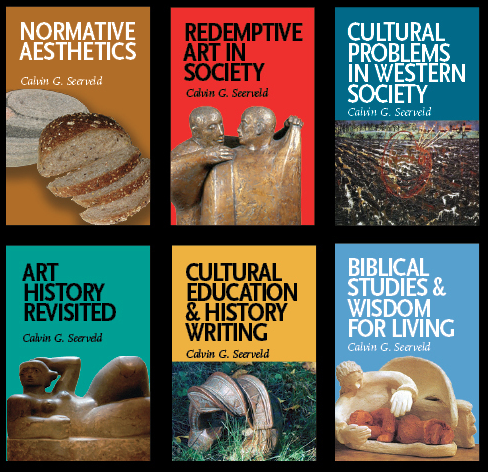
CULTURAL HISTORY AND EDUCATION WRITING // CULTURAL PROBLEMS IN WESTERN SOCIETY
Perhaps some readers who know of Seerveld’s work as art critic and advocate for a reformational aesthetics, or as a Bible scholar who speaks at worship conferences, especially on the use of the Psalms in liturgy, may wonder what these last two volumes are about. It isn’t easy to ever say what any of Cal’s books are “about” as they are so colorfully written, always so deeply Biblical, informed by his serious study of theology and philosophy, and his concern for the ordinary people of God, that all are always about many things at once. These two collections, though, are a great example of his interdisciplinary interests (and expertise.)
As I mentioned above, I briefly told about the two of them earlier in the year for a review column that I do called “Politics and Prose” for Capitol Commentary, published by the Christian political think-tank, the Center for Public Justice.
I exclaimed there that those seeking more profound thinking about contemporary socio-political problems would be wise to study with Seerveld as he brings his brilliant, prophetic imagination to bear on some of large issues of the age. As I note there, some of these talks were delivered at an annual conference in Europe, in part funded by the Dutch government, bringing together artists and cultural creative alongside educators, civic leaders, politicos and union leaders. It is almost unheard of in North America to see this kind of robust conversation among public leaders and faith leaders that is intellectually meaty and multi-dimensional.
Artist or activist, these essays are worth your consideration, and would bring a refreshingly rare vision and tone and direction to your work.
That review of these two is short, and you could quickly read it here — but do come back here, please!
A few chapters in Cultural Education & History Writing deserve special mention, as they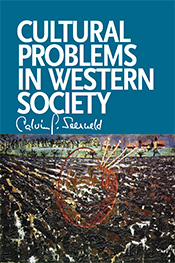
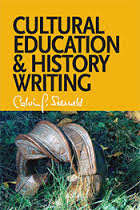 are important to at least a few of our BookNotes readers. There is reprinted an important speech offered at the founding of a Christian college in Korea. It is amazing — “Why Should a University Exist?” If you are in higher education, this is well worth pondering.
are important to at least a few of our BookNotes readers. There is reprinted an important speech offered at the founding of a Christian college in Korea. It is amazing — “Why Should a University Exist?” If you are in higher education, this is well worth pondering.
And, importantly included here is Seerveld’s passionate, important, wise contribution to a complex conference a few years back called “Beyond Worldview” which tried to argue through the usefulness, or harmfulness, of using the word “worldview.” Many of those pieces were published in a vastly under-rated, important book After Worldview edited by Matt Bonzo and Michael Stevens.
Cal’s piece here from that event is called “The Damages of a Christian Worldview” and is lovingly dedicated to one of my own influences, the Western Pennsylvania reformational philosopher and preacher, Peter J. Steen (1936 – 1984.) It is a good piece; it makes me happy that Seerveld loved Pete, and gave him this small honor.
Pete Steen would want you to read “Jubilee on the Job” a prophetic, astute, and powerful keynote offered at the 50th anniversary of the Christian Labour Association of Canada. It isn’t the only piece in here on the dignity and hardships of work. I’m so glad that one is in here. Anyone reading about faith and the marketplace, Christian views of work and vocation must read a few of these good papers.
And it may be a bit “insider baseball” for some, but his short piece from The Banner called “Thinking Deeply About Our Faith” honors some of his own influences. He talks about meeting a famous Dutch pastor who was a survivor of the Dachau concentration camp and a bookseller, and the colorful H. Evan Runner, and their passionate arguments as they discussed Trinity Christian College (where Seerveld first taught) and the founding of ICS in Toronto. There were conversations between folks at Calvin and Regent in BC and Westminster Seminary in Philadelphia (and, even, the CCO in Pittsburgh.) It is a nice, quick summary of some history that I’ve watched develop from afar.
Most of these pieces are brilliant, and substantive. I cannot recommend them enough for the educated Christian thinker who reads widely.
NORMATIVE AESTHETICS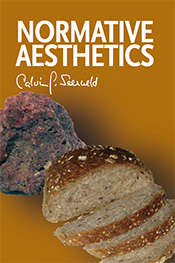
You may think that a book about Normative Aesthetics is a bit arcane, and I suppose it is. However, if you live in God’s world, you have know you experience the aesthetic dimension of life – God has given us “rainbows for the fallen world” after all. You attend to color, you listen to music, you choose clothing, you set your table for meals, you trim your trees, make a snowman; you do or don’t use banners and/or paraments at church, you send greeting cards not just by what they say, or choose fonts in blogs or use irony in your facebook profile. Maybe you like soccer, wax your car, pay somebody to style your hair, use certain affectations in your speech. Maybe you hang a painting in your home, maybe you have a favorite ceramic mug, maybe you tell a good joke. Perhaps you read novels, watch films, go to rock (or country or jazz or polka) shows, enjoy architecture, binge on TV shows, for better or worse. Maybe you judge a book by its cover.
Knowing a bit about this side of life, knowing a bit about the philosophy that underlies and shapes and informs appropriate thinking about aesthetics is certainly a must for artists, critics, or aficionados of the arts. (You do think there is good and bad art, don’t you? Also fashion or play or cooking? Of course — there are norms, perhaps what the Bible sometimes calls creational ordinances, which are more than principles, much more than “values” and really not at all what we say when we talk about our subjective tastes. Wow, come to think of it, we could all use a book or two with the word “normative” in the title — who doesn’t want to live life in sync with what is true and good and right?
You could give this to anyone who has already read a few books on culture-making or the arts and who needs a deeper underpinning, who wants to go a bit further in to the quest for Christian consideration, Christian thinking, Christian practice in the arts. Or give it to anyone who is smart enough to want to read seriously about this particular field.
Yes, there are chapter titles here like “Dooyeweeerd’s Legacy for Aesthetics: Modal Law Theory” which expands that nearly mystifying chapter at the heart of Rainbows for the Fallen World. His “A Turnabout in Aesthetics to Understanding” was his much-discussed inaugural lecture from the early 70s when he took up his chair at Toronto’s Institute for Christian Studies; I still have a few copies of it when it was sold as a small booklet! Lambert Zuidervaart’s wonderful, thick, helpful introduction to this volume is itself worth studying; it is called “(Un) Timely Voyage: Calvin Seerveld’s Normative Aesthetics.” It is meaty, intelligent, perspicacious, if you will.
But many of these chapters are fun for anyone, not just philosophers of aesthetics. I loved the one called “Joy, Style, and Aesthetic Imperatives, with the Biblical Meaning of Clothes and Games in the Christian Life.” His little piece “Ordinary Aesthetic Life: Humor, Tastes, and “Taking a Break” is wonderful and wise — who else writes stuff like this? I don’t know how many times I have read, over the years, his stunning “Christian Aesthetic Bread for the World.” “Both More and Less a Matter of Taste” is a bit heady, buy must-reading, I think, for anyone who wants to be faithful in our conversation about culture and social renewal in these days. His “Relation of the Arts to the Presentation of Truth” is passionate, serious, and very important.
What great blurbs grace the back, too.
James K.A. Smith notes not only how influenced he has been by Seerveld and how he has “drilled wells that Christians will drink from for years to come” but that it this release is perfectly timed:
Just as Christians in theology and the arts are becoming interested in the imagination, they can discover anew the philosophical wisdom of Seerveld’s normative aesthetics.
Nicholas Woltersdorf has a very gracious and helpful endorsement. So does Richard Mouw, who calls his work “ground-breaking” and reports that he “practices what he preaches. These fine essays both stimulate our imagination and offer us a gift of joy.”
This book is a true, joyous gift, a publishing event in itself, and I’m eager to have Hearts & Minds friends know of it. Will people buy a book on aesthetics (normative or otherwise?) We shall see. I suspect it won’t be a big seller at LifeWay or Barnes & Noble, but we do hope to sell a few, for God’s sake.
BIBLICAL LIVING & WISDOM FOR LIVING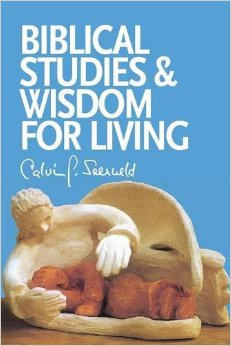
The volume in the set that may be most appealing to most BookNotes readers is the extraordinary (words fail me) writing and insight in Biblical Studies & Wisdom for Living. In this 425-page, thick volume – a volume that, again, is stunning in its breadth and erudite contribution – we have a wide array of his Biblical work.
Eugene Peterson, you might want to know, is a fan.
Of this new volume, he writes,
For those of us who have been led and directed by Calvin Seerveld’s books to develop artistic imagination as we read Scripture, receiving the narrative whole and integrated, this gathering of his occasional writings is sheer bonus. No one in my experience is more prescient in his alertness to the intertexuality of the entire Biblical canon. Under his influence I find myself listening to God’s voice in the Scriptures, not just reading God’s words.
Read that again, my friends.
Some of you may esteem the well-respected work of the Calvin Institute of Christian Worship, headed up by the remarkably ecumenical, surefire, John Witvliet, who grew up, I gather, with a steady diet of Seerveld.
Witvliet says of Biblical Studies & Wisdom for Living,
Vintage Seerveld — gutsy, wise, vivid, provocative, sanctifying… While several pieces directly address audiences and questions of particular significance to Reformed Christians, the patterns of thought reflected here will be inspiring and challenging to serious Christian believers in any tradition.
I sometimes call Cornelius Plantinga, a research fellow at said Calvin Institute, the patron saint of booksellers, not only for his many eloquent, broad-minded books about learning for God’s sake (like the lovely and valuable Engaging God’s World) but for his book about books and reading, Reading for Preaching. Plantinga says of this particular Seerveld volume in the new set,
This collection of Calvin Seerveld’s writings is a sheer gift. Highly intelligent, wide ranging, deeply revealing of the light of God, these lively pieces inform, delight, move the heart. They are at once provocative and reassuring, and they are, above all, wise.
Here are a few of the chapter titles of this one:
“Hearing God’s Narrative About ‘the way’ of Shalom”
“Reading and Hearing the Psalms: The Gut of the Bible”
“Pain is a Four Letter Word: A Congregational Lament.”
One long chapter is called “Five Psalms: For the American Guild of Organists” and in it he explores three Psalms. The bit on Psalm 19 he titled “Celebrating the good news of God’s creational ordinances and creatural glossolalia” and it is excellent; Psalm 30 is “A song written for a consecration service of the house of God” and one that “never gets old” is Psalm 96. The next two “psalms” in this chapter include poetic pieces from Isaiah and Revelation 18 (“Hip Hop millennial culture and Hallelujah!”)
I’m telling you, this is stuff that combines Hebrew scholarship, the history of exegesis, robust Reformed theology, worldviewish hope, brought out in creative, contemporary dunamis. It’s a pocketful of kyrptonite.
Other chapters in this volume bring greater detail: one chapter is on Proverbs 10 which he called “From Poetic Paragraphs to Preaching” and then there is a classic study of Proverbs 31 (which is entitled “Celebrate the Resourceful Woman.”) Excellent, fresh, insightful.
A few chapters are rather academic. For instance, one of Seerveld’s famous works is his script for a dramatization of Song of Songs called The Greatest Song. (We carry that rare, lovely book as well, by the way, with its evocative script, its handsome woodcuts, its Biblical heft and eroticism.) In one chapter with rich implications for any of us who read the Bible in fresh ways, he studies a literary critic named Herder who wrote and preached and translated in the mid-1700s, and anticipated contemporary conversations about hermeneutics raised by the likes of Gadamer, centuries later. This heady and fascinating bit of historical theology and aesthetics is called “Herder’s Revolutionary Hermeneutic and Aesthetic Theory: The Import of Herder’s Hermeneutics for Text Performance of The Greatest Song.” Okay, so it may not be for everybody.
A few of these pieces, though, are sermons, tough and tender and worth repeated readings. Peterson and the others are right, this is prescient and alert and leads us to God’s own voice! Try on “The Gift and Distraction of Pleasure” or “Longing to Lament: A Conversations Between Michael Card and Calvin Seerveld” (clear, honest, helpful!) or “We are Not Pilgrims: We are called to build tent cities in God’s world.” Amazing.
He has meditations here on marriage such as “The Tender, Tough Mystery of (Married) Love” and on friendship (“The Rare Gift of a Friend”) and remarkable pieces like “Ways-of-life and becoming elderly wise” and “Bastards or Sons of God?” I almost think that if some of us immersed ourselves in this kind of radical, integral Biblical reflection until it gets into our bones, we might be more healed and whole, less afraid and anxious, more bold and glad and good.
Some of the chapters in Biblical Studies and Wisdom were messages given on occasions such as college graduations or at associations of Christians schools or other denominational institutions. No matter your own denomination, you should read his “Modest Proposal for Reforming the Christian Reformed Church in North America” which will blow you away. His “Graduating to Glocal Martyrdom” is wondrously heavy – who says this kind of stuff at a commencement talk? He’s pretty tough, too, in another piece about higher education, although its rumination on 2 Corinthians 2: 14 – 3:6 would be powerfully applied to your church or fellowship group as well — it is called “The Smell of Your School: A Letter of Reference?” Wow.
Seerveld shows his cross-cultural humility (and savvy) in his fabulously interesting study of Say Amen, Somebody! the 1983 documentary about black gospel music and Thomas Dorsey. His first line in this great chapter is, “Say Amen, Somebody! should be seen by every sourpuss in the church.” As he narrates his own experiences in black churches, his study of gospel music, we learn so much. There is one great episode of going to black churches with his friend, the Dutch art historian Hans Rookmaaker in the early 60’s; included is a great grainy picture of Rookmaaker and Mahalia Jackson from 1961. Oh my, this is precious stuff, and I hope you realize it.
I could say more about this large volume, as there is so much more. Allow me to name one more chapter.
One of Seerveld’s most popular and often-re-printed short pieces is included here. “How to Read the Bible as a Grown Up Child” gives a broad, serious, clever, passionate reminder of how to approach the story of God revealed in the Scriptures. It is wonderful, just wonderful.
Seerveld has a short, meaty book called How To Read the Bible To Hear God Speak: A Study in Numbers (an earlier version old fans of his know as Balaam’s Apocalyptic Prophecies: A Study in Reading Scripture) which compares four different hermeneutical methods (from fundamentalist literalism to hyper-Reformed dogmatism to liberal higher criticism to postmodern engagement) naming the strengths and sometimes deadly weaknesses of each camp’s approach. He mostly shows a better, redemptive way, as he guides us how to read the Bible by preaching it so well, and by using it in such a fruitful, lively way in all his scholarship.
But this little piece that is in the Biblical Studies & Wisdom volume – about being a “grown up child” — is delightful and good, and captures this vision, explored in his bigger book on reading the Bible, and his devotionals, such as Take Hold of God and Pull. Is it an overstatement to say you should buy this book so you have easy access to this one “How to Read the Bible Like a Grown-Up Child” essay? Perhaps. But I could say that about half of amazing pieces here: it is well worth owning this book so you can draw on these pieces for the rest of your life.
ART HISTORY REVISITED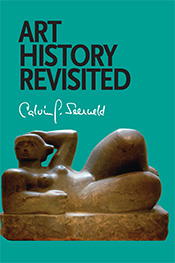
Well. This is where it gets serious, friends, and this is where Seerveld perhaps shines in his own field, beyond what I can adequately express. I know some of you will love this book, and some of you should give it to somebody you know.
Seerveld has been honored for his astute contributions to this field; he has done as much on a uniquely Christian, reformational method, than anyone in our lifetime, perhaps ever. (He has a thrilling, invaluable chapter in a book on the methods of doing art history Christianly, a festschrift in honor of the famed Wheaton College art professor, John Walford, called Art as Spiritual Perception: Essays in Honor of E. John Walford edited by James Romaine.)
And in Art History Revisited we see him in action. And, it is something — yes, the aforementioned “publishing event.” As Nigel Halliday from the UK writes,
Seerveld writes with the learned precision of the academic, but also with the passion and wry humour of a man rationally and emotionally convinced that we are God’s creatures living in God’s world…. the result is writing that brings art and artists to life, whether from this age or ages past, and makes us reflect seriously about our own lives.
James Romaine (President of the Association of Scholars of Christianity in the History of Art) notes,
Cal Seerveld brings fresh insights to the methods and motivations of art… Seerveld’s practice of identifying connections across periods of art history manifests a belief in God’s authority over the entirety of history and culture. His is a pursuit of the divine continuity that binds and gives meaningful significance to the ordinary particulars of historical and cultural moments.
There is some slow sledding here, rich and fruitful. For those that follow these things, Seerveld tends to appreciate the scholarly philosophy of Dirk Vollenhoven, the brother-in-law of cosmonomic Christian philosopher, Herman Dooyeweerd, and has several chapters here such as “Vollehnoven’s Legacy for Art Historiography.” Some of this deep background philosophy about the very nature of God’s real world offers a lens for him, which enables him to write remarkably prophetic pieces such as “Methodological Notes for Assessing What Happened 1764 – 1831 in the History of Aesthetics” and “The Moment of Truth and Evidence of Sterility within Neoclassical Art and Aesthetic Theory of the Later Enlightenment.” There are Biblical insights here, and he explains it, too: see the chapter “Biblical wisdom underneath Vollenhoven’s Categories…” Whew.
Part Two of this heady volume gives some delightful and inspiring examples of his methods by doing some nice case studies, truly revisiting art history, bit by bit. Whether you know much about this stuff or not, it is great, informative reading, a great way to learn a lot. He looks, for instance, at “Telltale Statues in Watteau’s Painting” and studies Hogwarth, Anton Raphael Mengs, and the wonderful contemporary wood engraving of Peter S. Smith. What great chapters! Know these artists or not, these are informative, inspiring pieces of fruitful Christian reflection. Anyone with interest in Christians working contemporary visual arts will love, and deeply appreciate his wonderful essay called “Redemptive Grit: The Ordinary Artistry of Gerald Folkerts.”
REDEMPTIVE ART IN SOCIETY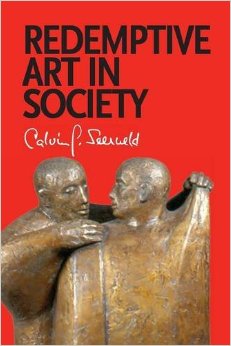
This is another favorite in the set, and it is one to which I had the immeasurable honor of adding an endorsing blurb. That Seerveld or his chief editor (from Dordt College Press) John Kok thought I might have some wisdom to impart here was a blessing for me — foolishness on their part, some might say. Ha! But there I am, next to Hans Rookmaaker’s wondrously artful daughter, editor-in-chief of ArtWay, Marleen Hengelaar-Rookmaaker, on the same page with scholar Jeremy Begbie, now of Duke Divinity School, and Makoto Fujimura.
Here is what Mako wrote,
Dr. Seerveld’s carefully crafted, scintillating, poetic words… are, to me, shalom promises, wisdom given to encourage artists in a broken, dark, and yet glorious (New York.) to only seek the best, to integrate one’s life and one’s art, and to bathe everything in prayer. I am grateful for his words: I am grateful for this book.
I appreciate what Begbie says,
Countless artists and theoreticians have been nourished by Cal Seerveld’s vivid and striking wisdom. These extraordinarily wide-ranging essays will not disappoint those who have followed his work, and those who are new to his unique voice will be greatly enriched.
But, you know, I hate to say it, but I think that the Borger guy captured best the tone and value of this particular volume, this one called Redemptive Art in Society. Here is what I said:
Can high quality, properly nuanceful, allusive theatre, sculpture, painting or song help heal the world? Can art expose injustices, bring comfort to the hurting, shake the idols of our age? These chapters are amazing pieces, a true gift for those wanting to go further along the journey towards “seeking the peace of the city.” Wise leaders and faithful artists simply must read them.
Yeah, I believe truly that. Art can change the world. (Perhaps you saw my review in Capitol Commentary of Fierce Convictions: The Extraordinary Life of Hannah More: Poet, Reformer, Abolitionist by Karen Swallow Prior, about the Victorian-ear British societal reformer, high-class cultural leader, educator, writer, and friend of the famous politician William Wilberforce.) I think this is very, very important stuff.
As Seerveld predecessor at ICS, Adrienne Dengerink Chaplin, writes in a moving, important introduction to this one,
“What would art look like that liberates, reconciles, reforms, and edifies?” That is the driving question throughout this collection of writings and lectures by Calvin Seerveld.”
She opens her superb introduction by writing about Seerveld’s important lectures given in South Africa during the days after the worst of the apartheid years. She cites a line he gave there, a line I heard in the mid-70s that impacted me like Richard Wright’s famous “punch to the solar plexus.”
“In my country on Friday nights youths die by the thousands culturally at the movies, and ten thousands are stunted by their weekend videos.”
The antidote, he says, is normative aesthetics, lived out, real and raw. “The best defense against attractive superficiality in the arts is a tough, home-bred imaginative fiber.” Or, as he puts it elsewhere, “art is like minerals in one’s food, the fiber to one’s diet, whose nutritives one hardly notices unless you become malnourished and it is determined that iron or ruffage has been missing from your daily bread.” As Adrienne puts it, “For Seerveld, wholesome bread — artistic, ludic, theatrical — is a recurrent image of the redemptive role of art in society.”
Seerveld cares deeply about public justice, about politics and economics, labor and freedom and shalom, real hurting people in a polluted world. But let me be clear: although he cares about the “redemptive role” of art in society — thee are chapters here where he talks about inner city murals and shares his passion for the “displaced” and, as we noted, about liberation in places like South Africa — this collection is not about social justice propaganda, about harnessing the arts for some just project. No — just like we realize that cheesy, evangelical preaching in the guise of, say, contemporary worship choruses or Christian-radio-friendly simplistic Christian pop, is often less than artistically mature, thin and not adequately nuanceful, so agit-prop, Christian preachments even about peace and justice, are not the calling of the mature artist, either, and not what ordinary folk should hunger for.
Redemptive art is gritty, but not propaganda. We bring “fresh olive leaves” announcing shalom, but we don’t have to sacrifice metaphor, allusion, suggestion — we “tell it slant” — let alone excellence and craft. Seerveld has thought harder and written more significantly than anybody I know about the ways in which art can enhance cities, how imaginativity is important for human dignity, how allusive artistry can enhance our cultural flourishing in ways that screeds and propaganda cannot.
As with the other volumes, Redemptive Art in Society includes some pretty scholarly pieces here, and then there are others that are so brilliant, and so fascinating and hopeful, that I’d wish everyone would read and study and ponder them. “The Challenge to Be Imaginative Salt in God’s World” is a near manifesto for relevant, socially-poignant Christian art. His message “For the Next Generation of Christian Writers of Literature” is a must for creative writers and readers of novels. He has an important little piece on poetry. He offers more than one piece on theater, a must for actors, writers, or anybody who enjoys going off Broadway.
Seerveld is especially attuned to the life of the city (and he has often shared insights about the murals of Diego Riviera.) This is excellent stuff for urban ministers, city planners, those called to reflect on the “sidewalks of the Kingdom” and “the spaces between us” as Christian new urbanist Eric O. Jacobsen puts it. But it isn’t just about public art and social renewal. Again, this is a book about the consequences of good aesthetic theory and the impact of mature Christian art and artful appreciation. I love this book!
A publishing event it is.

SIX VOLUMES
These six volumes collect, as we’ve seen, a real variety of styles — sermons, Bible studies, short magazine pieces, letters, even, next to scholarly essays and academic publications. And they cover a variety of themes explored by Seerveld in his sundry and occasional work. Some of these pieces are nearly legendary, a few are famous. Most, though, are virtually unknown, and we hope that this new collection will make his sustained, on-going work well known, from sea to shining sea. This really is great stuff, and we are more than please, we are compelled to tell you about it.
This series from Dr. Calvin Seerveld are among the most important and meaningful books I have been pleased to try to sell in our thirty plus years of selling books coram deo.
I trust you enjoyed reading about them, hearing about this fine scholar and eccentric cheerleader for the arts. I trust you will consider parting with some of your hard earned cash to buy a few, if not all. These are the sorts of books that last a lifetime, a wish investment, important for God’s glory, in God’s world, for those starved for lack of mature Christian theories about important aspects of our lives in God’s good but broken world.
Who else has written a chapter called “Joy, Style, and Aesthetic Imperatives with the Biblical Meaning of Clothes and Games in the Christian Life”?
Who else takes a course on popular song-writing so he can learn how his students might counter “formulaic meretricious songs” and does so in light of global starvation and real poverty, with a photo of an African shanty-town, beside a Picasso piece an Rembrandt self portrait?
Seerveld laments those who are
smothered by the clutter of huge, repetitive blinking billboards signs 7/24 for corporate advertising, turning the place into a marketing venue. There is more than one way to be killed: commercialistic anaestheticzed place can have the forlorn mark of a Las Vegas virtual cemetery.
Well, this is amazing writing, colorful, demanding, serious, a bit playful, stunning. There is no other author like him, and we cannot thank Dordt College Press quite enough for bringing these pieces into the publishing world.
We can tell you about them, though, and pray that you help us spread the word about them, curious and winsome and learned and full of prophetic imagination that they are. You’ve not seen anything like them, I am sure. These books are remarkable, and we are happy to tell you — someday in the Kingdom Hall of Fame I will be vindicated, if you don’t believe me — that this batch of books being released this fall is a true publishing event.
Or, as the kids say these days: A. True. Publishing. Event.
The gifts of God for the people of God.
Thanks be to God.

YOU CAN BUY ANY ONE AT 20% OFF.
IF YOU BUY THE WHOLE SET, WE”LL SELL THEM AT 25% OFF AND WE WILL SEND ALONG (WHILE SUPPLIES LAST) A NICE ART BOOK, A COFFEE TABLE GIFT BOOK THAT SEERVELD LIKES.
NICE, eh?
Here are the mundane details:
We’ll show the regular price, and our BookNotes 20% sale price.
Normative Aesthetics $21.00 our sale price $16.80
Cultural Education & History Writing $23.00 our sale price $18.40
Cultural Problems in the West $17.00 our sale price $13.60
Biblical Studies & Wisdom for Living $25.00 our sale price $20.00
Art History Revisted $20.00 our sale price $16.00
Redemptive Art in Society $21.00 our sale price $16.80
BookNotes
DISCOUNT
ANY ITEM MENTIONED
20% off
order here
takes you to the secure Hearts & Minds order form page
just tell us what you want
inquire here
if you have questions or need more information
just ask us what you want to know
Hearts & Minds 234 East Main Street Dallastown, PA 17313 717-246-3333
